A Rapid Thermal Absorption Rate and High Latent Heat Enthalpy Phase Change Fiber Derived from Bio-Based Low Melting Point Copolyesters
Abstract
:1. Introduction
2. Experimental Section
2.1. Materials
2.2. Synthesis of PBHA-Cn Copolymers
2.3. Blending
2.4. Melt Spinning
2.5. Drawing
2.6. Instrumental Methods
3. Results and Discussion
3.1. Copolymer Synthesis and Characterization
3.2. Blends of Copolymers and PBT
3.3. Fiber Production and Characterization of Properties
4. Conclusions
Supplementary Materials
Author Contributions
Funding
Institutional Review Board Statement
Informed Consent Statement
Data Availability Statement
Conflicts of Interest
References
- Yang, K.; Venkataraman, M.; Zhang, X.; Wiener, J.; Zhu, G.; Yao, J.; Militky, J. Review: Incorporation of Organic PCMs into Textiles. J. Mater. Sci. 2022, 57, 798–847. [Google Scholar] [CrossRef]
- Zhang, N.; Yuan, Y.; Cao, X.; Du, Y.; Zhang, Z.; Gui, Y. Latent Heat Thermal Energy Storage Systems with Solid-Liquid Phase Change Materials: A Review. Adv. Eng. Mater. 2018, 20, 1700753. [Google Scholar] [CrossRef]
- Alva, G.; Lin, Y.; Liu, L.; Fang, G. Synthesis, Characterization and Applications of Microencapsulated Phase Change Materials in Thermal Energy Storage: A Review. Energy Build. 2017, 144, 276–294. [Google Scholar] [CrossRef]
- Chalco-Sandoval, W.; Fabra, M.J.; López-Rubio, A.; Lagaron, J.M. Use of Phase Change Materials to Develop Electrospun Coatings of Interest in Food Packaging Applications. J. Food Eng. 2017, 192, 122–128. [Google Scholar] [CrossRef]
- Zhu, C.; Chen, Y.; Cong, R.; Ran, F.; Fang, G. Improved Thermal Properties of Stearic Acid/High Density Polyethylene/Carbon Fiber Composite Heat Storage Materials. Sol. Energy Mater. Sol. Cells 2021, 219, 110782. [Google Scholar] [CrossRef]
- Iqbal, K.; Khan, A.; Sun, D.; Ashraf, M.; Rehman, A.; Safdar, F.; Basit, A.; Maqsood, H.S. Phase Change Materials, Their Synthesis and Application in Textiles—a Review. J. Text. Inst. 2019, 110, 625–638. [Google Scholar] [CrossRef]
- Yang, K.; Wiener, J.; Venkataraman, M.; Wang, Y.; Yang, T.; Zhang, G.; Zhu, G.; Yao, J.; Militky, J. Thermal Analysis of PEG/Metal Particle-Coated Viscose Fabric. Polym. Test. 2021, 100, 107231. [Google Scholar] [CrossRef]
- Peng, H.; Wang, J.; Zhang, X.; Ma, J.; Shen, T.; Li, S.; Dong, B. A Review on Synthesis, Characterization and Application of Nanoencapsulated Phase Change Materials for Thermal Energy Storage Systems. Appl. Therm. Eng. 2021, 185, 116326. [Google Scholar] [CrossRef]
- Qureshi, Z.A.; Ali, H.M.; Khushnood, S. Recent Advances on Thermal Conductivity Enhancement of Phase Change Materials for Energy Storage System: A Review. Int. J. Heat Mass Transf. 2018, 127, 838–856. [Google Scholar] [CrossRef]
- Ran, F.; Chen, Y.; Cong, R.; Fang, G. Flow and Heat Transfer Characteristics of Microencapsulated Phase Change Slurry in Thermal Energy Systems: A Review. Renew. Sustain. Energy Rev. 2020, 134, 110101. [Google Scholar] [CrossRef]
- Tauseef-ur-Rehman; Ali, H.M.; Janjua, M.M.; Sajjad, U.; Yan, W.-M. A Critical Review on Heat Transfer Augmentation of Phase Change Materials Embedded with Porous Materials/Foams. Int. J. Heat Mass Transf. 2019, 135, 649–673. [Google Scholar] [CrossRef]
- Gadhave, P.; Pathan, F.; Kore, S.; Prabhune, C. Comprehensive Review of Phase Change Material Based Latent Heat Thermal Energy Storage System. Int. J. Ambient Energy 2021, 1–26. [Google Scholar] [CrossRef]
- Safari, A.; Saidur, R.; Sulaiman, F.A.; Xu, Y.; Dong, J. A Review on Supercooling of Phase Change Materials in Thermal Energy Storage Systems. Renew. Sustain. Energy Rev. 2017, 70, 905–919. [Google Scholar] [CrossRef]
- Prajapati, D.G.; Kandasubramanian, B. A Review on Polymeric-Based Phase Change Material for Thermo-Regulating Fabric Application. Polym. Rev. 2020, 60, 389–419. [Google Scholar] [CrossRef]
- Liu, H.; Wei, Z.; He, W.; Zhao, J. Thermal Issues about Li-Ion Batteries and Recent Progress in Battery Thermal Management Systems: A Review. Energy Convers. Manag. 2017, 150, 304–330. [Google Scholar] [CrossRef]
- Sarier, N.; Onder, E. Organic Phase Change Materials and Their Textile Applications: An Overview. Thermochim. Acta 2012, 540, 7–60. [Google Scholar] [CrossRef]
- Purohit, B.K.; Sistla, V.S. Inorganic Salt Hydrate for Thermal Energy Storage Application: A Review. Energy Storage 2021, 3, e212. [Google Scholar] [CrossRef]
- Khadiran, T.; Hussein, M.Z.; Zainal, Z.; Rusli, R. Encapsulation Techniques for Organic Phase Change Materials as Thermal Energy Storage Medium: A Review. Sol. Energy Mater. Sol. Cells 2015, 143, 78–98. [Google Scholar] [CrossRef]
- Pereira da Cunha, J.; Eames, P. Thermal Energy Storage for Low and Medium Temperature Applications Using Phase Change Materials—A Review. Appl. Energy 2016, 177, 227–238. [Google Scholar] [CrossRef]
- Hsu, K.-H.; Chen, C.-W.; Wang, L.-Y.; Chan, H.-W.; He, C.-L.; Cho, C.-J.; Rwei, S.-P.; Kuo, C.-C. Bio-Based Thermoplastic Poly(Butylene Succinate-Co-Propylene Succinate) Copolyesters: Effect of Glycerol on Thermal and Mechanical Properties. Soft Matter 2019, 15, 9710–9720. [Google Scholar] [CrossRef]
- Chen, C.-W.; Hsu, T.-S.; Rwei, S.-P. Effect of Ethylenediaminetetraacetic Acid on Unsaturated Poly(Butylene Adipate-Co-Butylene Itaconate) Copolyester with Low-Melting Point and Controllable Hardness. Polymers 2019, 11, 611. [Google Scholar] [CrossRef] [PubMed]
- Chan, H.; Cho, C.; Hsu, K.; He, C.; Kuo, C.; Chu, C.; Chen, Y.; Chen, C.; Rwei, S. Smart Wearable Textiles with Breathable Properties and Repeatable Shaping in In Vitro Orthopedic Support from a Novel Biomass Thermoplastic Copolyester. Macromol. Mater. Eng. 2019, 304, 1900103. [Google Scholar] [CrossRef]
- Chen, C.-W.; Mao, H.-I.; Yang, Z.-Y.; Huang, K.-W.; Yan, H.-C.; Rwei, S.-P. Synthesis of Bio-Based Poly(Butylene Adipate-Co-Butylene Itaconate) Copolyesters with Pentaerythritol: A Thermal, Mechanical, Rheological, and Molecular Dynamics Simulation Study. Polymers 2020, 12, 2006. [Google Scholar] [CrossRef] [PubMed]
- Chen, C.-W.; Hsu, T.-S.; Huang, K.-W.; Rwei, S.-P. Effect of 1,2,4,5-Benzenetetracarboxylic Acid on Unsaturated Poly(Butylene Adipate-Co-Butylene Itaconate) Copolyesters: Synthesis, Non-Isothermal Crystallization Kinetics, Thermal and Mechanical Properties. Polymers 2020, 12, 1160. [Google Scholar] [CrossRef] [PubMed]
- Gerkman, M.A.; Han, G.G.D. Toward Controlled Thermal Energy Storage and Release in Organic Phase Change Materials. Joule 2020, 4, 1621–1625. [Google Scholar] [CrossRef]
- Sharma, R.K.; Ganesan, P.; Tyagi, V.V.; Metselaar, H.S.C.; Sandaran, S.C. Developments in Organic Solid–Liquid Phase Change Materials and Their Applications in Thermal Energy Storage. Energy Convers. Manag. 2015, 95, 193–228. [Google Scholar] [CrossRef]
- Fallahi, A.; Guldentops, G.; Tao, M.; Granados-Focil, S.; Van Dessel, S. Review on Solid-Solid Phase Change Materials for Thermal Energy Storage: Molecular Structure and Thermal Properties. Appl. Therm. Eng. 2017, 127, 1427–1441. [Google Scholar] [CrossRef]
- Pielichowska, K.; Pielichowski, K. Phase Change Materials for Thermal Energy Storage. Prog. Mater. Sci. 2014, 65, 67–123. [Google Scholar] [CrossRef]
- Militky, J.; Novak, O.; Kremenakova, D.; Wiener, J.; Venkataraman, M.; Zhu, G.; Yao, J.; Aneja, A. A Review of Impact of Textile Research on Protective Face Masks. Materials 2021, 14, 1937. [Google Scholar] [CrossRef] [PubMed]
- Faheem, S.; Baheti, V.; Tunak, M.; Wiener, J.; Militky, J. Flame Resistance Behavior of Cotton Fabrics Coated with Bilayer Assemblies of Ammonium Polyphosphate and Casein. Cellulose 2019, 26, 3557–3574. [Google Scholar] [CrossRef]
- Venkataraman, M.; Mishra, R.; Militky, J.; Xiong, X.; Marek, J.; Yao, J.; Zhu, G. Electrospun Nanofibrous Membranes Embedded with Aerogel for Advanced Thermal and Transport Properties. Polym. Adv. Technol. 2018, 29, 2583–2592. [Google Scholar] [CrossRef]
- Khan, M.Z.; Baheti, V.; Militky, J.; Ali, A.; Vikova, M. Superhydrophobicity, UV Protection and Oil/Water Separation Properties of Fly Ash/Trimethoxy(Octadecyl)Silane Coated Cotton Fabrics. Carbohydr. Polym. 2018, 202, 571–580. [Google Scholar] [CrossRef] [PubMed]
- Yang, T.; Xiong, X.; Mishra, R.; Novák, J.; Militký, J. Sound Absorption and Compression Properties of Perpendicular-Laid Nonwovens. Text. Res. J. 2019, 89, 612–624. [Google Scholar] [CrossRef]
- Yang, K.; Periyasamy, A.P.; Venkataraman, M.; Militky, J.; Kremenakova, D.; Vecernik, J.; Pulíček, R. Resistance against Penetration of Electromagnetic Radiation for Ultra-Light Cu/Ni-Coated Polyester Fibrous Materials. Polymers 2020, 12, 2029. [Google Scholar] [CrossRef]
- Zhang, X.; Jin, Z.; Hu, L.; Zhou, X.; Yang, K.; Kremenakova, D.; Militky, J. A Silver Yarn-Incorporated Song Brocade Fabric with Enhanced Electromagnetic Shielding. Materials 2021, 14, 3779. [Google Scholar] [CrossRef] [PubMed]
- Zhang, X.; Jin, Z. A Kind of Song Brocade Fabric with NFC Data Masking Function Used for Making Purse. IOP Conf. Ser. Mater. Sci. Eng. 2018, 389, 12037. [Google Scholar] [CrossRef]
- Wang, Y.; Baheti, V.; Yang, K.; Yang, T.; Wiener, J.; Militký, J. Utility of Whiskerized Carbon Fabric Surfaces in Resistive Heating of Composites. Polym. Compos. 2021, 42, 2774–2786. [Google Scholar] [CrossRef]
- Periyasamy, A.P.; Yang, K.; Xiong, X.; Venkataraman, M.; Militky, J.; Mishra, R.; Kremenakova, D. Effect of Silanization on Copper Coated Milife Fabric with Improved EMI Shielding Effectiveness. Mater. Chem. Phys. 2020, 239, 122008. [Google Scholar] [CrossRef]
- Iqbal, K.; Sun, D. Development of Thermo-Regulating Polypropylene Fibre Containing Microencapsulated Phase Change Materials. Renew. Energy 2014, 71, 473–479. [Google Scholar] [CrossRef]
- Iqbal, K.; Sun, D.; Stylios, G.K.; Lim, T.; Corne, D.W. FE Analysis of Thermal Properties of Woven Fabric Constructed by Yarn Incorporated with Microencapsulated Phase Change Materials. Fibers Polym. 2015, 16, 2497–2503. [Google Scholar] [CrossRef]
- Fredi, G.; Bruenig, H.; Vogel, R.; Scheffler, C. Melt-Spun Polypropylene Filaments Containing Paraffin Microcapsules for Multifunctional Hybrid Yarns and Smart Thermoregulating Thermoplastic Composites. Express Polym. Lett. 2019, 13, 1071–1087. [Google Scholar] [CrossRef]
- Tomaszewski, W.; Twarowska-Schmidt, K.; Moraczewski, A.; Kudra, M.; Szadkowski, M.; Pałys, B. Nonwovens with thermal storage properties based on paraffin–modified polypropylene fibres. Fibres Text. East. Eur. 2012, 96, 64–69. [Google Scholar]
- Xia, W.; Xiang, H.; Zhou, Z.; Fei, X.; Zhu, M. Hybridizing Rational Designed Hydrophobic PEG-Based Derivatives into Nanoporous F–SiO2 as Form-Stable Phase Change Materials for Melt-Spun PA6 Phase Change Fibers with a Superior Washing Durability. Compos. Commun. 2021, 24, 100633. [Google Scholar] [CrossRef]
- Xia, W.; Fei, X.; Wang, Q.; Lu, Y.; Innocent, M.T.; Zhou, J.; Yu, S.; Xiang, H.; Zhu, M. Nano-Hybridized Form-Stable Ester@F-SiO2 Phase Change Materials for Melt-Spun PA6 Fibers Engineered towards Smart Thermal Management Fabrics. Chem. Eng. J. 2021, 403, 126369. [Google Scholar] [CrossRef]
- Cherif, C.; Tran, N.H.A.; Kirsten, M.; Bruenig, H.; Vogel, R. Environmentally Friendly and Highly Productive Bi-Component Melt Spinning of Thermoregulated Smart Polymer Fibres with High Latent Heat Capacity. Express Polym. Lett. 2018, 12, 203–214. [Google Scholar] [CrossRef]
- Liang, Z.; Pan, P.; Zhu, B.; Inoue, Y. Isomorphic Crystallization of Poly(Hexamethylene Adipate- Co -Butylene Adipate): Regulating Crystal Modification of Polymorphic Polyester from Internal Crystalline Lattice. Macromolecules 2010, 43, 6429–6437. [Google Scholar] [CrossRef]
- Liang, Z.; Pan, P.; Zhu, B.; Yang, J.; Inoue, Y. Critical Role of the Conformation of Comonomer Units in Isomorphic Crystallization of Poly(Hexamethylene Adipate-Co-Butylene Adipate) Forming Poly(Hexamethylene Adipate) Type Crystal. Polymer 2011, 52, 5204–5211. [Google Scholar] [CrossRef]
- Bang, H.-J.; Kim, H.-Y.; Jin, F.-L.; Park, S.-J. Fibers Spun from 1,4-Cyclohexanedimethanol-Modified Polyethylene Terephthalate Resin. J. Ind. Eng. Chem. 2011, 17, 805–810. [Google Scholar] [CrossRef]
- Chen, T.; Zhang, W.; Zhang, J. Alkali Resistance of Poly(Ethylene Terephthalate) (PET) and Poly(Ethylene Glycol-Co-1,4-Cyclohexanedimethanol Terephthalate) (PETG) Copolyesters: The Role of Composition. Polym. Degrad. Stab. 2015, 120, 232–243. [Google Scholar] [CrossRef]
- Tsai, Y.; Jheng, L.-C.; Hung, C.-Y. Synthesis, Properties and Enzymatic Hydrolysis of Biodegradable Alicyclic/Aliphatic Copolyesters Based on 1,3/1,4-Cyclohexanedimethanol. Polym. Degrad. Stab. 2010, 95, 72–78. [Google Scholar] [CrossRef]
- Debuissy, T.; Pollet, E.; Avérous, L. Synthesis of Potentially Biobased Copolyesters Based on Adipic Acid and Butanediols: Kinetic Study between 1,4- and 2,3-Butanediol and Their Influence on Crystallization and Thermal Properties. Polymer 2016, 99, 204–213. [Google Scholar] [CrossRef]
- Wang, B.; Zhang, Y.; Song, P.; Guo, Z.; Cheng, J.; Fang, Z. Synthesis, Characterization, and Properties of Degradable Poly(l-Lactic Acid)/Poly(Butylene Terephthalate) Copolyesters Containing 1,4-Cyclohexanedimethanol. J. Appl. Polym. Sci. 2011, 120, 2985–2995. [Google Scholar] [CrossRef]
- Tsai, Y.; Fan, C.-H.; Hung, C.-Y.; Tsai, F.-J. Amorphous Copolyesters Based on 1,3/1,4-Cyclohexanedimethanol: Synthesis, Characterization and Properties. J. Appl. Polym. Sci. 2008, 109, 2598–2604. [Google Scholar] [CrossRef]
- Liu, J.; Ye, H.-M.; Xu, J.; Guo, B.-H. Formation of Ring-Banded Spherulites of a and b Modifications in Poly(Butylene Adipate). Polymer 2011, 52, 4619–4630. [Google Scholar] [CrossRef]
- Avrami, M. Kinetics of Phase Change. II Transformation-Time Relations for Random Distribution of Nuclei. J. Chem. Phys. 1940, 8, 212–224. [Google Scholar] [CrossRef]
- Mao, H.-I.; Wang, L.-Y.; Chen, C.-W.; Hsu, K.-H.; Tsai, C.-H.; Cho, C.-J.; Yu, Y.-Y.; Rwei, S.-P.; Kuo, C.-C. Enhanced Crystallization Rate of Bio-Based Poly(Butylene Succinate-Co-Propylene Succinate) Copolymers Motivated by Glycerol. J. Polym. Res. 2021, 28, 92. [Google Scholar] [CrossRef]
- Chen, C.-W.; Hsu, T.-S.; Rwei, S.-P. Isothermal Kinetics of Poly(Butylene Adipate- Co -Butylene Itaconate) Copolyesters with Ethylenediaminetetraacetic Acid. ACS Omega 2020, 5, 3080–3089. [Google Scholar] [CrossRef]
- Mao, H.-I.; Chen, C.-W.; Rwei, S.-P. Synthesis and Nonisothermal Crystallization Kinetics of Poly(Butylene Terephthalate-Co-Tetramethylene Ether Glycol) Copolyesters. Polymers 2020, 12, 1897. [Google Scholar] [CrossRef]
- Yu, F.; Xiao, L. Non-Isothermal Crystallization Kinetics of Poly(Ether Sulfone) Functionalized Graphene Reinforced Poly(Ether Ether Ketone) Composites. Polym. Test. 2021, 97, 107150. [Google Scholar] [CrossRef]
- Grasser, W.; Schmidt, H.-W.; Giesa, R. Fibers Spun from Poly(Ethylene Terephthalate) Blended with a Thermotropic Liquid Crystalline Copolyester with Non-Coplanar Biphenylene Units. Polymer 2001, 42, 8517–8527. [Google Scholar] [CrossRef]
- Le Moigne, N.; van den Oever, M.; Budtova, T. Dynamic and Capillary Shear Rheology of Natural Fiber-Reinforced Composites. Polym. Eng. Sci. 2013, 53, 2582–2593. [Google Scholar] [CrossRef]
- Gupta, B.; Revagade, N.; Anjum, N.; Atthoff, B.; Hilborn, J. Preparation of Poly(Lactic Acid) Fiber by Dry-Jet-Wet-Spinning. I. Influence of Draw Ratio on Fiber Properties. J. Appl. Polym. Sci. 2006, 100, 1239–1246. [Google Scholar] [CrossRef]
- Tomisawa, R.; Ikaga, T.; Kim, K.H.; Ohkoshi, Y.; Okada, K.; Masunaga, H.; Kanaya, T.; Masuda, M.; Maeda, Y. Effect of Draw Ratio on Fiber Structure Development of Polyethylene Terephthalate. Polymer 2017, 116, 357–366. [Google Scholar] [CrossRef]
- Nejman, A.; Gromadzińska, E.; Kamińska, I.; Cieślak, M. Assessment of Thermal Performance of Textile Materials Modified with PCM Microcapsules Using Combination of DSC and Infrared Thermography Methods. Molecules 2019, 25, 122. [Google Scholar] [CrossRef] [PubMed]
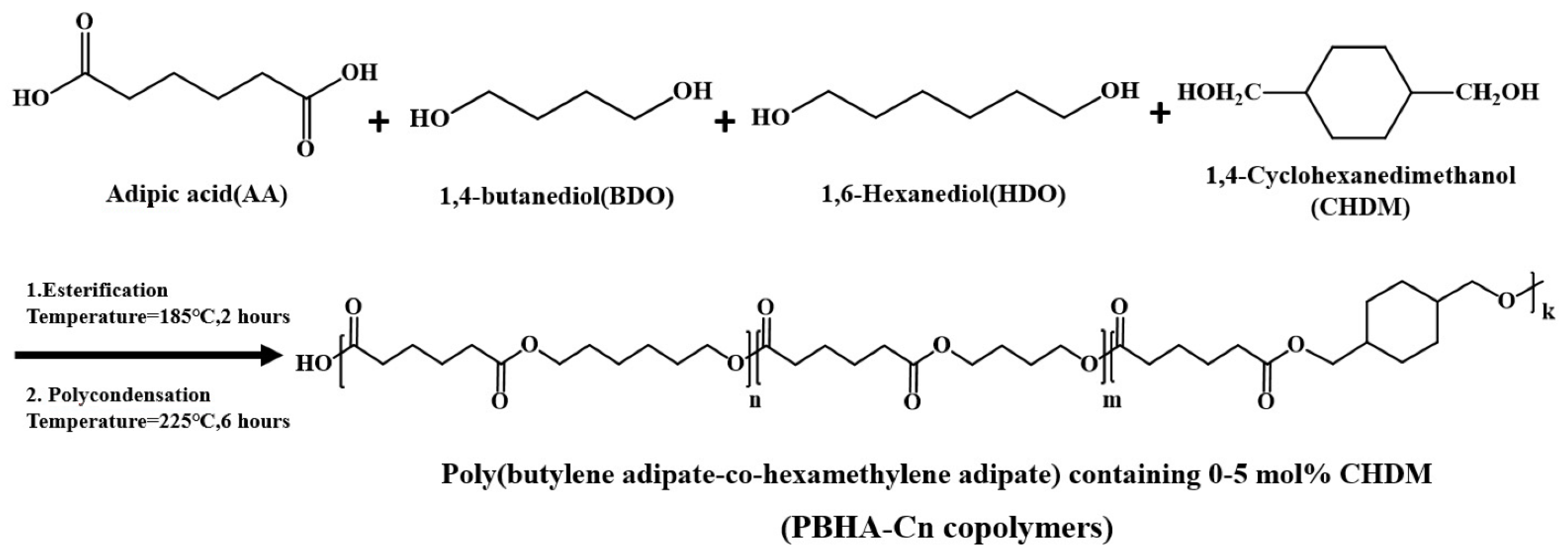
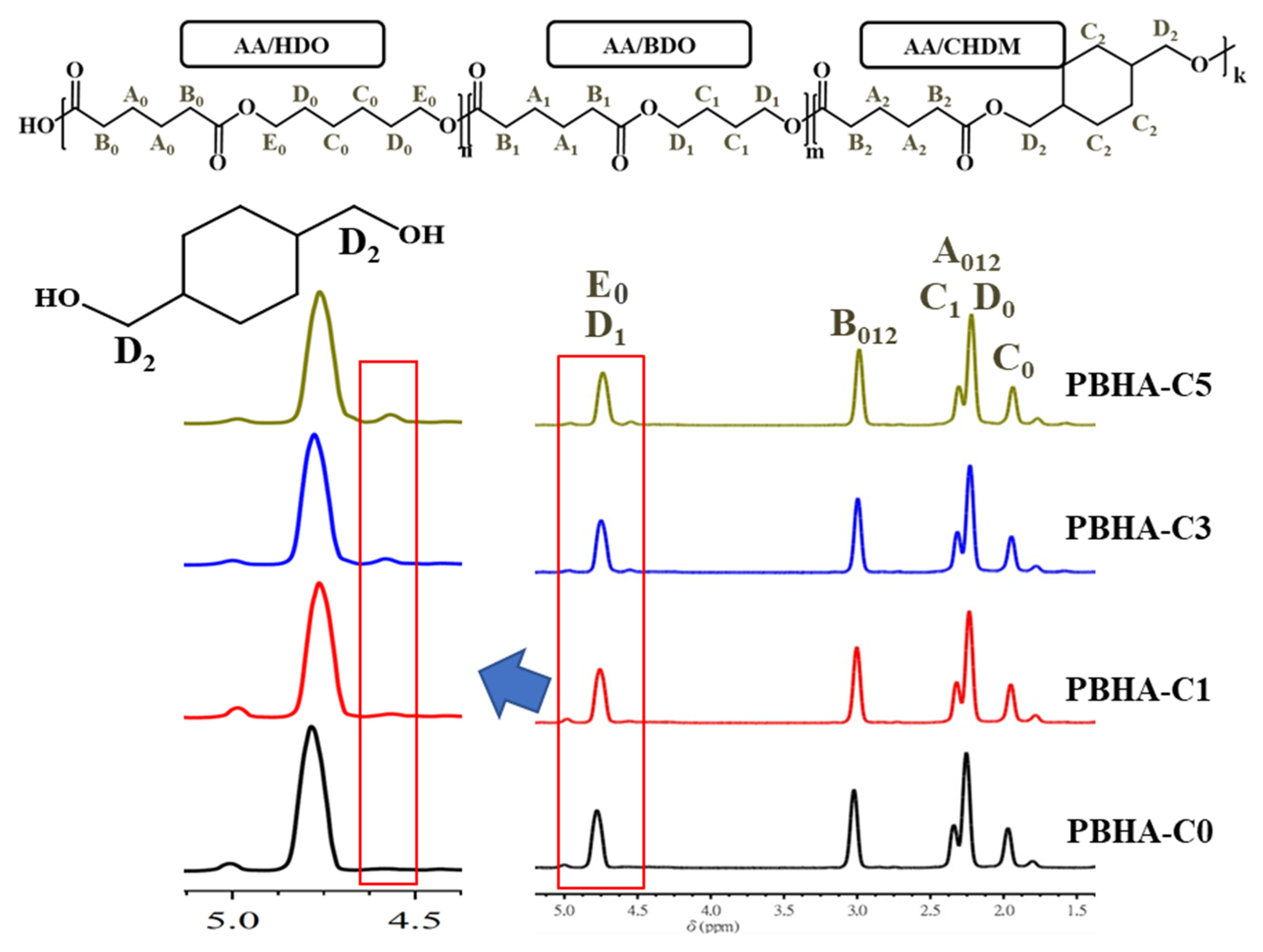

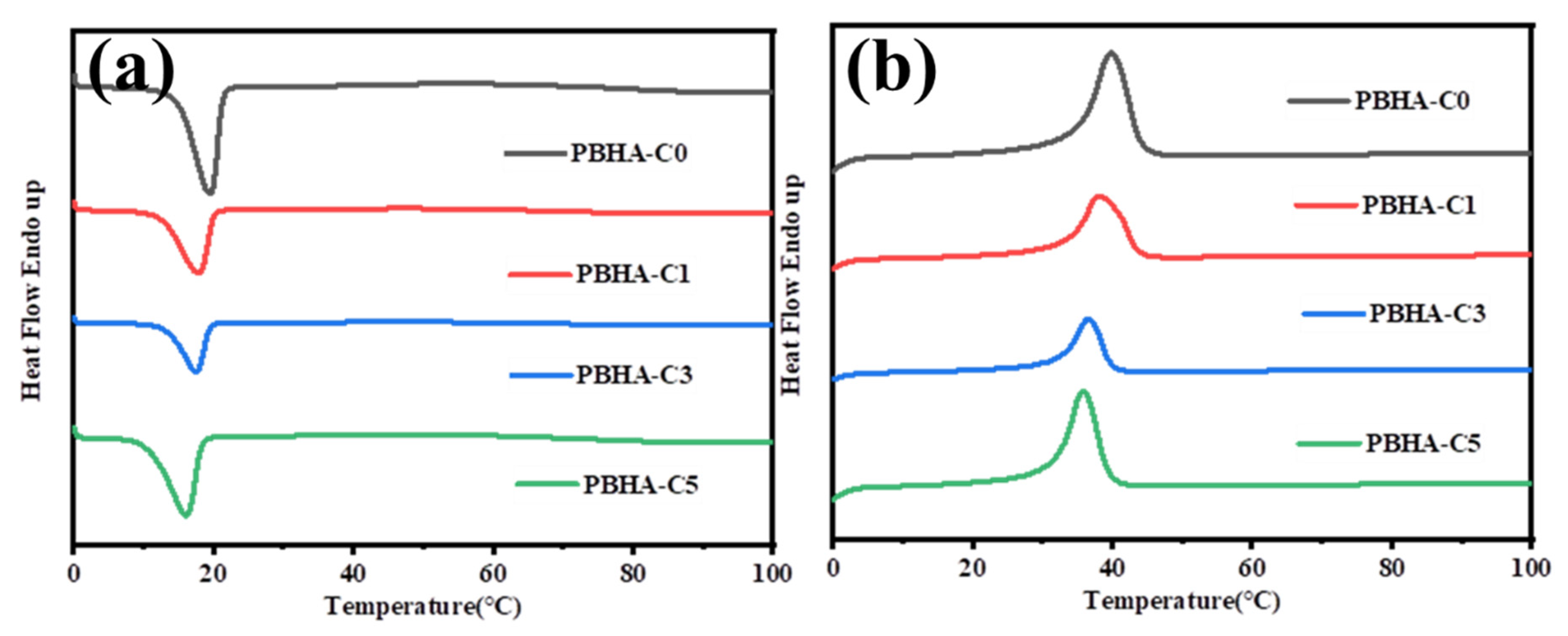


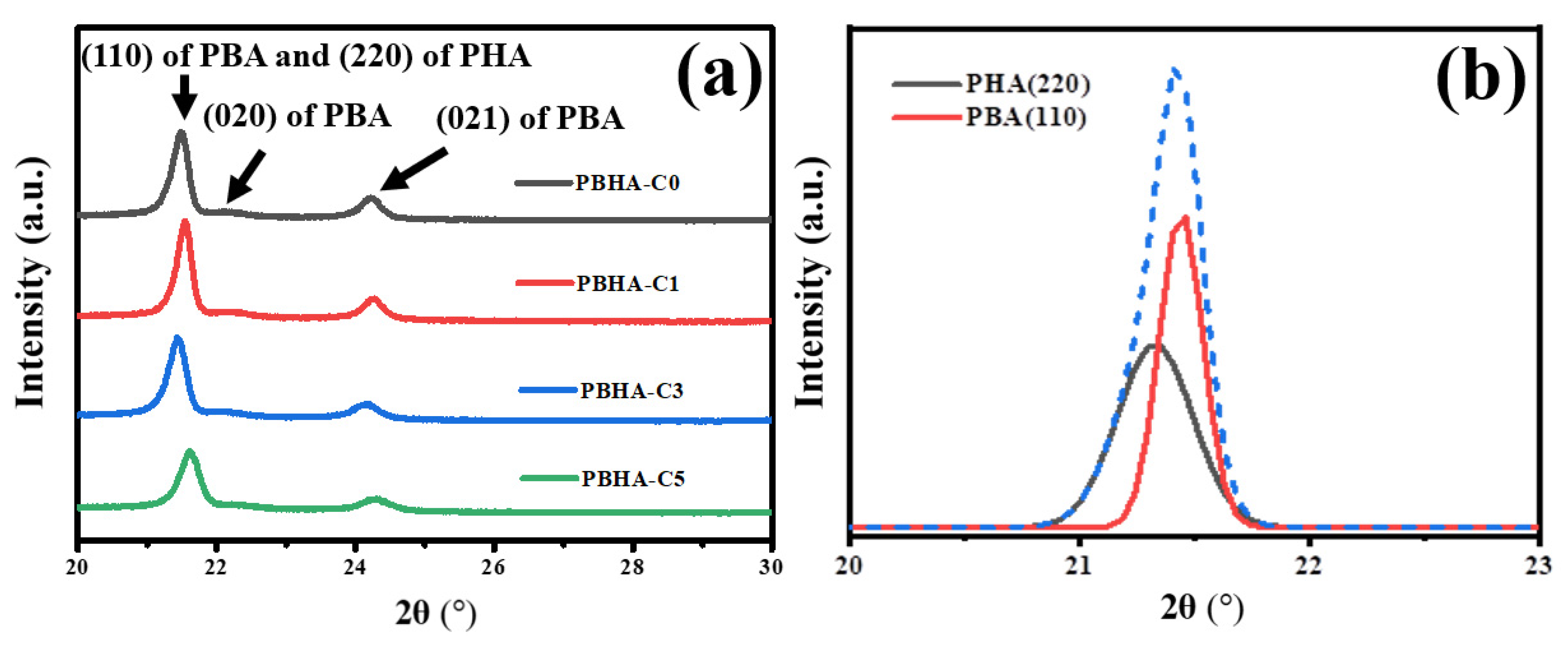
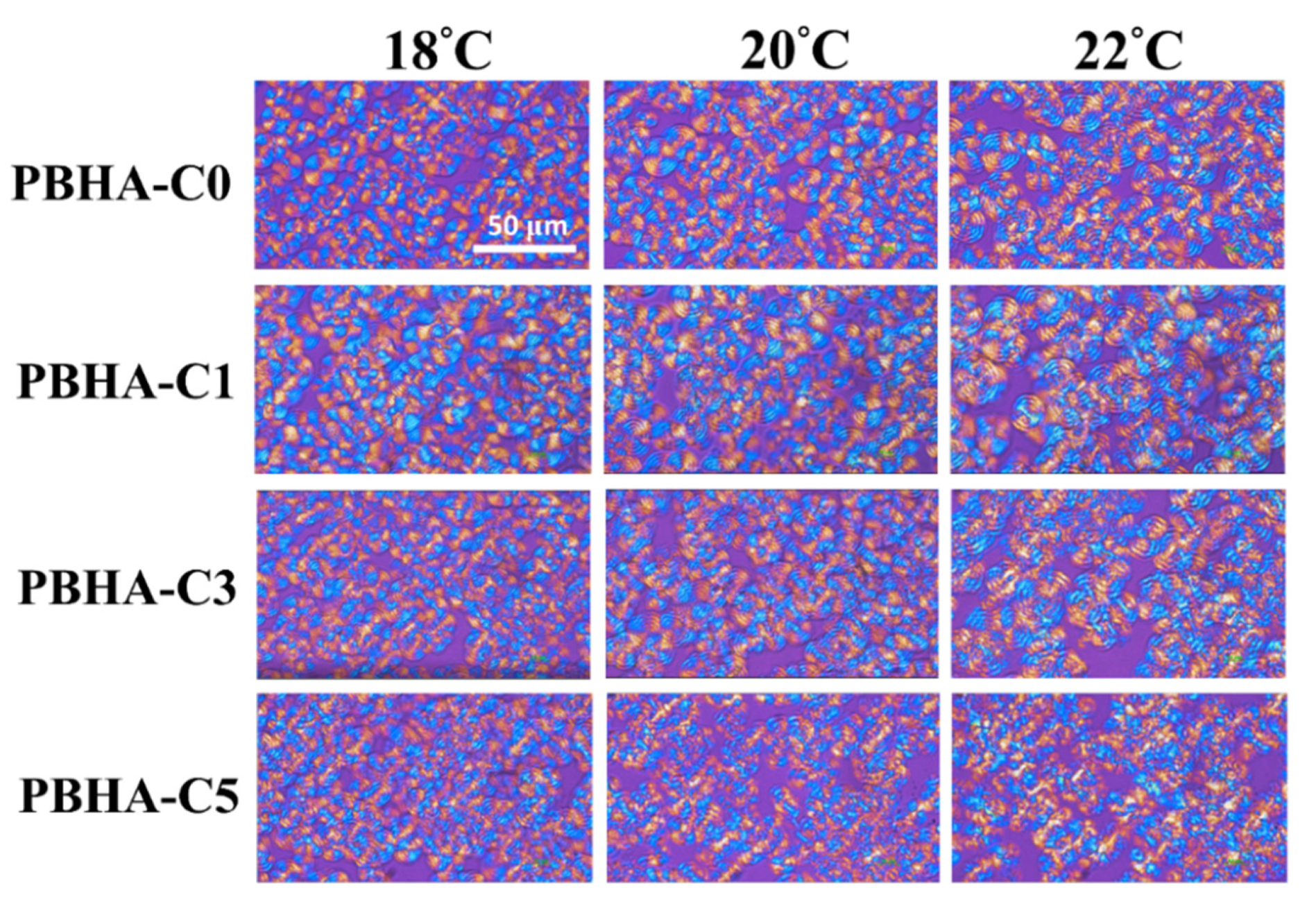





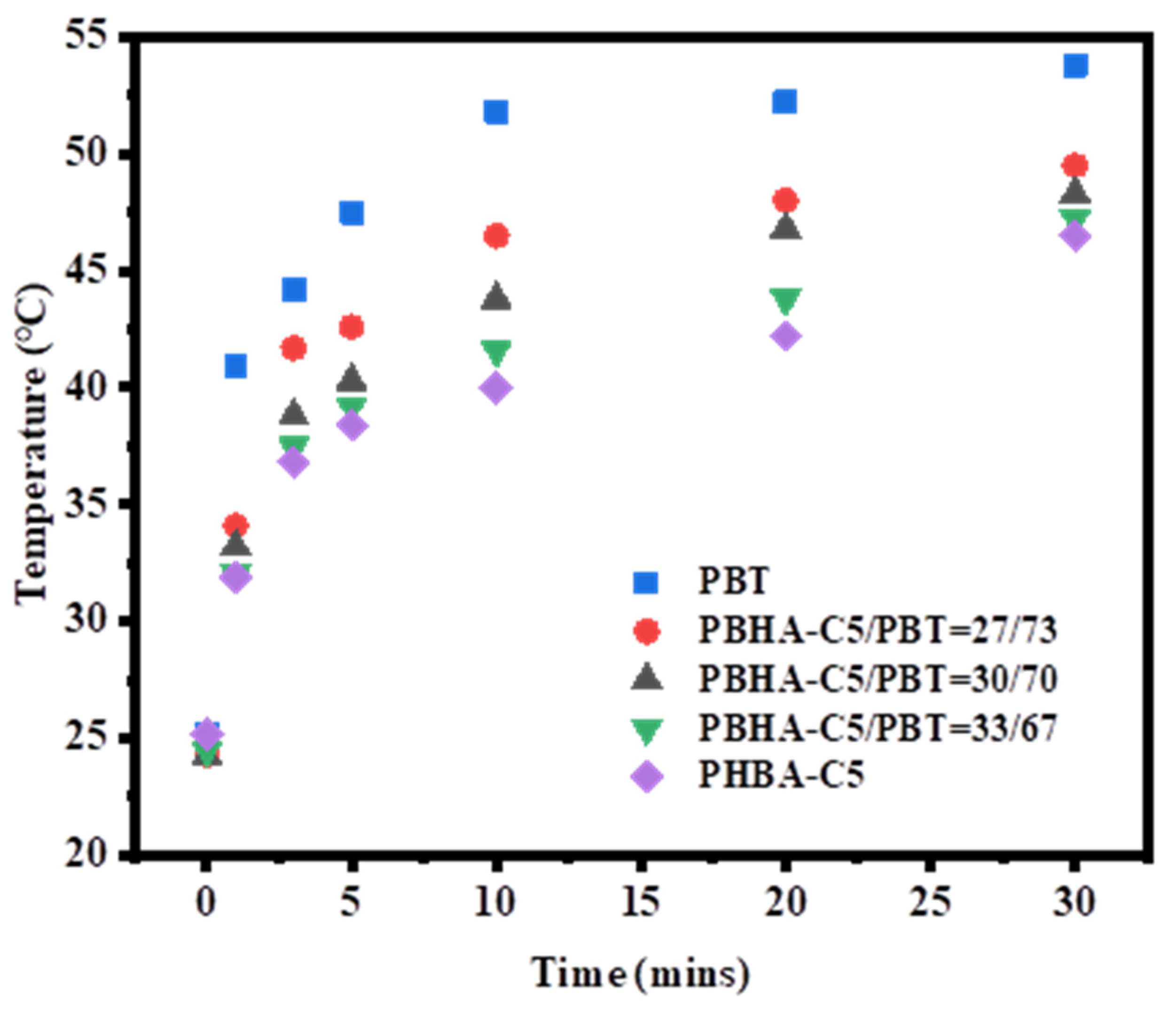
| Sample | Mn | Mw | Mw/Mn | BDO/HDO/CHDM Feed Ratio | BDO/HDO/CHDM Calculated |
|---|---|---|---|---|---|
| (g mol−1) | (g mol−1) | (Đ) | (mole %) | (mole %) | |
| PBHA-C0 | 34,800 | 106,100 | 3.07 | 52.5/47.5/0 | 52/48/0 |
| PBHA-C1 | 36,600 | 113,300 | 3.09 | 52/47/1 | 51/48/1 |
| PBHA-C3 | 36,800 | 109,500 | 2.96 | 51/46/3 | 50/47/3 |
| PBHA-C5 | 31,100 | 83,300 | 2.57 | 50/45/5 | 49/47/4 |
| Sample | Tm a (°C) | ∆Hm a (J g−1) | Tc a (°C) | ∆Hc a (J g−1) | Td-5% b (°C) | Tg c (°C) |
|---|---|---|---|---|---|---|
| PBHA-C0 | 39.8 | 48.9 | 19.5 | 49.5 | 332.7 | −58.9 |
| PBHA-C1 | 38.1 | 49.0 | 17.8 | 48.7 | 337.5 | −55.2 |
| PBHA-C3 | 36.5 | 44.9 | 17.5 | 45.3 | 334.1 | −53.9 |
| PBHA-C5 | 35.7 | 43.9 | 16.1 | 45.2 | 336.5 | −52.4 |
Publisher’s Note: MDPI stays neutral with regard to jurisdictional claims in published maps and institutional affiliations. |
© 2022 by the authors. Licensee MDPI, Basel, Switzerland. This article is an open access article distributed under the terms and conditions of the Creative Commons Attribution (CC BY) license (https://creativecommons.org/licenses/by/4.0/).
Share and Cite
Lan, T.-Y.; Mao, H.-I.; Chen, C.-W.; Lee, Y.-T.; Yang, Z.-Y.; Luo, J.-L.; Li, P.-R.; Rwei, S.-P. A Rapid Thermal Absorption Rate and High Latent Heat Enthalpy Phase Change Fiber Derived from Bio-Based Low Melting Point Copolyesters. Polymers 2022, 14, 3298. https://doi.org/10.3390/polym14163298
Lan T-Y, Mao H-I, Chen C-W, Lee Y-T, Yang Z-Y, Luo J-L, Li P-R, Rwei S-P. A Rapid Thermal Absorption Rate and High Latent Heat Enthalpy Phase Change Fiber Derived from Bio-Based Low Melting Point Copolyesters. Polymers. 2022; 14(16):3298. https://doi.org/10.3390/polym14163298
Chicago/Turabian StyleLan, Tsung-Yu, Hsu-I Mao, Chin-Wen Chen, Yi-Ting Lee, Zhi-Yu Yang, Jian-Liang Luo, Pin-Rong Li, and Syang-Peng Rwei. 2022. "A Rapid Thermal Absorption Rate and High Latent Heat Enthalpy Phase Change Fiber Derived from Bio-Based Low Melting Point Copolyesters" Polymers 14, no. 16: 3298. https://doi.org/10.3390/polym14163298








